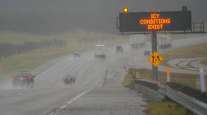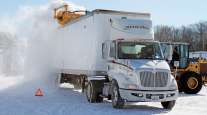Staff Reporter
Frozen Road Rules Start to Take Hold, Allowing for Heavier Truckloads

Roads in certain portions of Midwestern states can accommodate heavier truckloads as seasonal weight increases gradually take effect.
When the ground beneath a highway’s pavement freezes, the route can handle more weight. States such as Minnesota and Wisconsin issue regional load increase advisories, which allow truckers to haul heavier shipments.
The Minnesota Department of Transportation recently announced that winter load increases took effect in the state’s Central frost zone Dec. 14. MnDOT divides the state into six frost zones. The northernmost two — North and North-Central — already have load increases in effect. The Central zone stretches across Minnesota like a belt, touching the borders of South Dakota and Wisconsin. Its eastern portion is located directly north of the Metro zone, which encompasses the Twin Cities.
[NEWS] Winter truck load increases begin Dec. 3 for north-central frost zone https://t.co/ivteMi0QwE
— MnDOT (@MnDOTnews) November 30, 2018
The increase allows vehicles in Minnesota to carry loads up to 10% over the standard legal maximum weight. For example, a truck that can legally carry 80,000 pounds would be allowed to carry up to 88,000 pounds. Shelly Meyer, oversize overweight permits supervisor for MnDOT’s Office of Freight and Commercial Vehicle Operations, explained that such overweight trucks need to have a permit if they plan to travel on the interstate system.
“Essentially, now you can go from the Canadian border to halfway down the state and use those increased weights and, south of that line, you can’t,” Minnesota Trucking Association President John Hausladen said. “We are recognizing the fact that essentially the ground is freezing hard enough that we can put additional weight on the pavement without any excess damage.”

Hausladen
Certain haulers carrying oversize and overweight loads can exceed the 88,0000-pound mark. Drivers who have permits to haul forest products can regularly carry 90,000 pounds. These trucks, which must have six axles, transport paper, pulp, lumber and barrel staves. During winter weight-increase periods, forest product haulers can haul up to 99,000 pounds, but they must stay off interstate routes.
These weight-increase periods are important for timber processors, who work long hours when wintertime road laws are in effect to offset the times they cannot work during the spring thaw, which occurs when the snow melts, weakening the pavement above it.
“Probably the industry that has the biggest benefit is the timber industry,” Hausladen said. “For those industries where heavy loads are important, this is an important tool for them.”

Truck on a Minnesota highway. (Dave Gonzalez — Minnesota Department of Transportation)
Similarly, Wisconsin institutes a “frozen road” law during the winter. The law takes effect once the ground under highway pavement is frozen to a depth of at least 18 inches. When that occurs, the maximum gross weight for trucks with a minimum of five axles that are hauling logs, salt or sand is raised from 80,000 pounds to 98,000 pounds.
The Wisconsin Department of Transportation announced the start of a frozen road period in Zone 1, the state’s northernmost region, Dec. 12. WisDOT spokesman David Hunt said the frozen road law probably will take effect in the state’s four remaining zones over the next several weeks.
Wisconsin’s frozen road declaration pertains only to state routes. Neal Kedzie, president of the Wisconsin Motor Carriers Association, said that the trucking industry works closely with the state’s more than 1,200 townships, which determine when local roads need to be posted for weight limitations. He noted that towns’ budgets are largely impacted by road costs.
“It’s something that we have to deal cooperatively with multiple units of government, be it state, be it county, be it towns, cities and villages,” Kedzie said. “We’re respectful of that and try to apply good, sound science when we make and state our cases for any changes to the current laws.”




